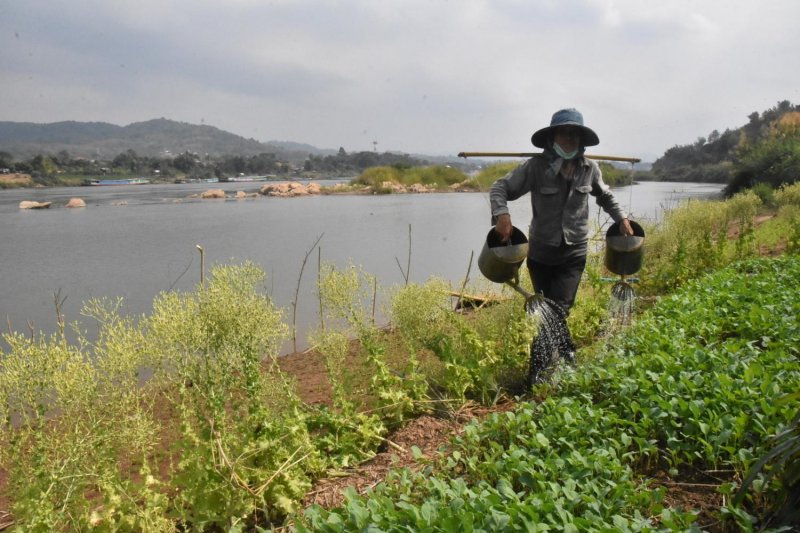
A fisherman walks along the Mekong River on the Thai-Lao border. The transboundary river has been found to be contaminated by arsenic from rare earth mines in Myanmar. (Photo: Pianporn Deetes)
‘If the river could cry, it would have cried already. But now it is me who can no longer hold back tears — because I can no longer use the Mekong River.”
Those were the words of Boontham, a 73-year-old fisherman in Ban Sob Kok in Chiang Rai, on the day he learned that the river he had lived with all his life was contaminated with toxic substances. Overnight, without warning and without any remedies, he lost not only his livelihood — but the river that had sustained his family for generations.
The tragedy unfolding today across mainland Southeast Asia is larger and more urgent than many realise. Our two major transboundary rivers — the Mekong and the Salween — are now in a state of emergency. Scientific tests show dangerous levels of heavy metal contamination far beyond safety limits, posing serious risks to public health and ecosystems.
Since local communities and civil society groups in Chiang Rai and Chiang Mai, including the Shan Human Rights Foundation, first raised the alarm about illegal mining in the upper Kok, Sai, and Mekong tributaries, every round of Thailand’s official water-quality tests — 12 consecutive times — has detected arsenic above national standards. This polluted water flows directly into the lower Mekong. Most recently, arsenic levels above the safety threshold have been found at the Thai–Lao border in Loei, Nong Khai, opposite Vientiane, and Nakhon Phanom.
Even the Salween River — one of the last free-flowing large rivers of the planet, fed by pristine Himalayan snowmelt — has two to five times the allowable arsenic limit along the Thai–Myanmar border, according to researchers from Chiang Mai University and the Pollution Control Department.
Once these toxins enter river ecosystems, they accumulate in food chains and silently build up in human bodies. The impact isn’t immediate, but irreversible.
The source of this pollution is no mystery: a rapidly expanding belt of illegal and unregulated mines in upstream Shan State and along many tributaries inside Myanmar. There are now almost a hundred of these rare earth, gold, and other high-value critical minerals mines operating with zero environmental oversight.
Starting today, the Mekong River Commission (MRC) Council will hold a two-day meeting on the banks of the Kok River, which has been known to be contaminated for more than eight months. The river is the source of raw water for Chiang Rai’s provincial water supply.
The meeting will approve the MRC’s 2026–2030 Strategic Plan, with priorities such as enhancing data, monitoring, and predictive capabilities for decision support, advancing coordinated river basin management operations, as well as active monitoring, water-quality management to support aquaculture and agriculture, etc.
But the most pressing questions cannot wait for another planning cycle.
Will the MRC openly acknowledge the emergency that is now unfolding? Will the MRC Council confront the reality that unregulated mining is destroying the basin’s lifelines?
Acknowledging the problem means MRC must be proactive by kickstarting a joint response to verify and address the source of the transboundary pollution. It means it must put in place scientifically sound plans to remediate the river ecosystem and surrounding areas. It also means stepping up to ensure that there is ongoing robust consultation along with meaningful participation of affected communities and civil society.
The MRC has long emphasised cooperation, data, and diplomacy. Yet today we face a crisis that is transboundary, criminal in nature, and accelerating. The contamination of the Mekong is not a distant threat — it is here, affecting tens of millions.
Grassroots communities have long resisted destructive blasting schemes and dam projects on the Mekong, working tirelessly to safeguard the river’s ecology, fisheries, and food security. As a result, despite those pressures, the Mekong remained usable; people could still drink from it, bathe in it, and sustain their livelihoods.
Now, the situation has become far more dire.
This crisis is the most serious the basin has experienced. The river that once supported everyday life is now hazardous to human health. Heavy metals and other toxins have entered the water, soil, and food chain — a direct consequence of unregulated mining in no-law zones and its growing role in the global supply chain for critical minerals.
At its core, this is a struggle for survival and justice. It concerns not only us but also the well-being of the next generations.

